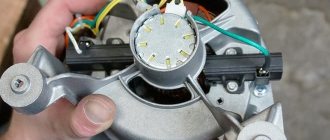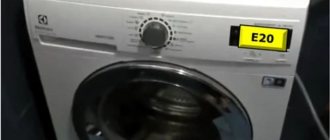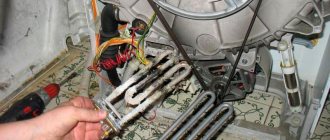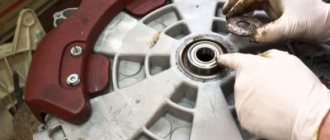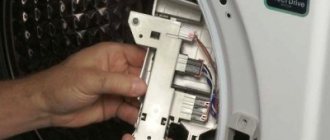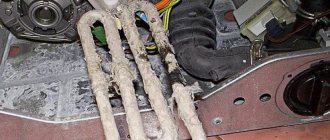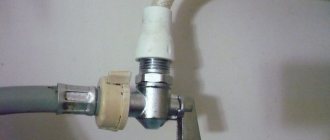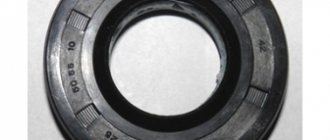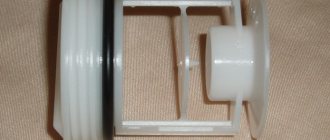For complete independent operation, washing machines are equipped with many components that work interconnectedly. These nodes are controlled by the control unit. This block turns on and off the necessary nodes and controls their operation throughout the entire program.
Components such as the drain pump, solenoid valve and heater have an on and off state, but the engine must develop and maintain different speeds, depending on the program. At the washing stage, it rotates the washing machine drum at a frequency of approximately 50 revolutions per minute, and during the spin cycle it is tens of times faster.
The operation of the engine is controlled by electronics, and a tachometer installed on the engine helps it with this.
The tachogenerator in a washing machine is designed to transmit the existing engine speed to an electronic module, which regulates it and maintains it at the desired speed.
The automatic washing machine engine speed is adjusted by the module by adjusting the current to power the motor.
What is a tachometer?
It looks like a metal ring from which the wires come. Tacho sensor in a washing machine - where is it located? It is mounted on the shaft of an electric motor, which, when rotating, creates a voltage that is picked up by the sensor. The amount of voltage created by the stator's electromagnetic field is directly proportional to the speed at which the shaft rotates. As the speed increases, the voltage increases.
What is a tachogenerator in a washing machine? Why does a device designed for washing clothes need this sophisticated counter? It measures the speed of the electric motor - it is calculated based on voltage readings. The sensor supplies information to the control board - this is how the drum speed is monitored. Taking into account the received data, the “brain” of the washing machine makes a decision - to increase or decrease the speed.
Signs of a Hall sensor malfunction
- Sudden change in speed.
- Things are wrung out poorly - you feel a lack of speed.
- When washing, the rotation is too fast - more than required.
Types of tachometers
There are 3 main types of tachometers.
These are mechanical, analog and digital. Let's consider each option separately. It is the very first type of tachometer, which was used on the first cars. The design of such a device was extremely simple: the device was connected directly to the crankshaft using a cable. The torque was transmitted to the gear and through the cable it went to the moving coil of the device. The device itself is an electromagnet, in which an increase in the number of revolutions contributed to the creation of the greatest magnetic induction. Thus, the higher the magnetic field, the more the needle on the scale deflects.
Despite its simple and reliable design, this device has a serious drawback. The fact is that it was impossible to accurately calculate the gear ratio, the torque of the cable and the magnetic field of the device. Therefore, such a tachometer had serious errors up to 500 rpm.
An analog tachometer is a more advanced type of mechanical device. This time, instead of a cable and connecting the device drive to the crankshaft, an engine ignition coil was used.
The pulse voltage generated on the ignition coil, in addition to the spark plugs, enters the circuit of the measuring device. The greater the number of pulses in the circuit, the stronger the magnetic induction generated. Accordingly, as the number of revolutions increases, the readings of the device also increase.
How to check the tachometer?
Do you want to make sure of the diagnosis? Then you need to check the tachogenerator. This is not easy to do - you have to dismantle the electric motor. In order not to disassemble the SMA in vain, you must first exclude other malfunctions that can cause similar symptoms:
- Check the spin key. Perhaps the button is simply pressed in and jammed, which led to the problem.
- Reboot SM. Unplug. After 15 minutes, turn it on. No change? Well, that means you need to check the sensor.
Dismantling works
Before checking the tachogenerator of the washing machine, you will have to disassemble the washing machine and remove the motor. Disassembly is carried out like this:
- The washing machine is disconnected from the network, water, and sewerage.
- Unscrew the screws on the back wall. Remove the back panel.
- Remove the drive belt. They pull it towards themselves, while turning the pulley with the other hand.
- Remove the electric motor. Before disconnecting the wires, take a photo so as not to make a mistake when connecting.
- Unscrew the bolts that secure the electric motor.
- Rock the engine from side to side and pull it out.
Look at the removed device and check whether its fastenings have become loose due to vibration. If necessary, tighten the mounting bolt. The contacts could also have come loose - then you just need to fix the connection.
How to measure the resistance of a tachometer?
You have found out that the fasteners and connections are in order, start testing the device. There are two checking options:
- Set the tester to resistance mode. Disconnect the wiring from the sensor. By touching the contacts with the probes, measure the resistance of the tachogenerator of the washing machine. For a working device it will be in the range of 60–70 Ohms.
- Select the voltage mode on the tester. You should find out whether there is current generation. If yes, the Hall sensor is not broken. Having touched the contacts with the probes, crank the engine with your other hand. Observe the readings - if they change (by approximately 0.2 V), then the device is functioning normally.
All that remains is to check whether the wiring is working properly. The sensor itself rarely fails. The most difficult case is a faulty control board. It is advisable to immediately contact a specialist with this problem.
If your washing machine malfunctions, there will be problems with the speed, you know what to do. Now you can not only diagnose, but also fix the problem yourself.
Source
Checking the sensor
If you decide to remove the motor and check the Hall sensor yourself, then we act strictly according to the instructions. But first, we mark the wiring connected to the electric motor or photograph everything with a camera. This will help avoid mistakes when reconnecting the engine. Next, we proceed as methodically as possible.
- Unscrew the bolts holding the engine.
- We loosen the engine to the sides, and then sharply pull it towards ourselves.
- We inspect the sensor and wires for integrity and reliability of fastening. It is likely that due to sudden jumps in speed, the contacts came loose or the latches became loose. Then all that remains is to restore the previous balance by clamping the terminals tighter.
When there is no visual damage or discharge, testing is necessary. It is carried out in two ways. In the first case, we set up a multimeter to measure ohms, loosen the wiring, apply probes to the contacts and evaluate the result. A value within 60-70 Ohms indicates the functionality of the sensor.
Another option is to measure the current generated by the tachogenerator. We switch the tester to voltage mode, connect the probes to the contacts, and accelerate the electric motor with our free hand
It is important here that a figure of about 0.2 Volt appears, which will prove the working condition of the device
In practice, the tachogenerator fails extremely rarely, and more often, interruptions in drum rotation occur due to the fault of the wiring and triacs of the control board. You can assess the integrity of the wires on your own by looking for traces of burning, pinching or detachment of contacts on visible cables. It is strongly not recommended to correct the situation with the control module on your own - it is cheaper and more reliable to immediately contact a service center.
LG washing machine direct drive. Hall sensor repair.
Share your opinion - leave a comment
The principle of operation of the tachogenerator in a washing machine
The principle of operation of the tachometer is quite simple. The tachogenerator itself is located on the motor shaft and is a small ring with wires. When the motor rotates in a ring, voltage is generated due to the magnetic field (generator principle), the higher the speed of rotation of the motor, the higher the voltage. Accordingly, by measuring this voltage, you can obtain the engine rotation speed.
It is to measure the engine rotation speed that the tachometer in the washing machine is used. The operating principle is as follows. Let's say the engine spins up and begins to rotate the drum, in order to activate the spin, you need to increase the engine speed to 800 rpm. The control module gives a signal and commands to increase engine speed, but when should you stop raising the speed? This is why a tachogenerator is needed; it constantly provides engine speed parameters and thereby allows the control module to make decisions about the engine rotation speed.
Symptoms of a faulty tachometer
If the tachometer in a washing machine breaks down, it begins to behave as follows. Since the number of revolutions is not controlled, the machine begins to rotate the drum at the wrong speed. During washing, the speed may be too high, but during spinning, on the contrary, the speed does not rise. The machine may not spin the laundry at all. Such “glitches” indicate that one of the reasons for their appearance may be the tachometer. To check the tachogenerator of a washing machine, you must first get to it.
Checking the brushes
Attention! The wear of the brush can be determined by visual inspection, the presence of sparks when the engine is running, or the appearance of sounds during washing.
Electric brushes can wear out due to an overloaded tank during washing, using maximum speed during spinning, and also when there is a short circuit in the turns of the motor winding. For each model of washing machine there is a certain type of brushes, which should be purchased in a specialized store.
Important! If the new brushes are not used to all parts of the engine compartment, strong sparks may occur.
Hard brushes will last longer, but excessive hardness can negatively affect the commutator and lead to its failure.
Where is the tachometer located in a washing machine?
The tachogenerator of the washing machine is located on the motor shaft, which is installed at the bottom of the washing machine. To get to the engine, you will need to remove the back wall of the machine. To do this, unscrew the bolts that secure this wall and remove it. The engine is located at the bottom and is connected by a belt to a pulley, you can see it right away.
The tachometer is located on the rear of the engine on the shaft. To check or replace it, you will need to remove the engine; this procedure is described in detail in the article on repairing a washing machine engine with your own hands.
In a machine with an inverter motor
Where is the Hall sensor located in washing machines of this type? It is located inside the electric motor. However, this arrangement will not prevent you from freely approaching the element. The sequence of actions will be as follows:
- remove the rear wall of the unit housing by unscrewing the bolts holding it. On some models of washing machines, the top cover may interfere with this, in which case it will have to be removed;
- inspect the inverter motor cover. It is located on the cross of the rear wall of the drum;
- Loosen the locking center nut and carefully remove the motor cover.
Removing the cover, you will see the tachometer. Once the location of this part has been determined, diagnostic measures can begin.
How to check the tachometer on a washing machine
To check the tachogenerator, it is not necessary to remove it from the engine, but the engine itself will have to be removed from the washing machine. First you need to remove the belt from the motor shaft. Next, tighten the bolts securing the motor, pull the motor out, having first disconnected the wires from it.
To check the tachometer for functionality, do the following:
- First, disconnect the tachometer wires from the connector, and then measure the resistance on them. To do this, you will need a multimeter, which must be set to resistance measurement mode. The normal resistance of the tachogenerator should be around 60 Ohms. By the way, you can perform this procedure without removing the engine from the washing machine.
- To make sure that the tachogenerator is working and producing current when the engine rotates, switch the multimeter to voltage measurement mode. While measuring the voltage at the tachometer terminals, turn the engine by hand. The tension must rise. When the motor is rotating, it is usually around 0.2V.
- If everything is fine, check the tachometer generator mounting bolt, very often it loosens and the sensor begins to “glitch”. If he is relaxed, tighten him up.
If your tachogenerator does not pass these tests and its mounting bolt is too tight, then it is time to change it. The tachometer most often breaks down due to the washing machine being overloaded.
How to diagnose an electronic temperature sensor (NTC)
The electronic sensor (NTC) changes its resistance as the temperature rises or rises. This is the basis for how to check the temperature sensor of a washing machine of this type. It is this particular feature of the operating principle that gives a 100% analysis result and makes the procedure simple.
You will need a multimeter; it is switched to resistance measurement mode; you can also use an ohmmeter. Next, the detector values are analyzed when exposed to different temperatures.
It is advisable to clarify the test results: compare the resistance of the temperature sensor, the temperature sensor of the washing machine with the table from the specification for a specific sensor model (data can be found on the manufacturers’ websites).
For example, we learn the relationship between the resistance of a thermal sensor and the temperature on an LG washing machine from the specification table for a specific detector with a certain marking:
Algorithm:
- We disconnect the chip and remove the sensor from the socket.
- We switch the multimeter to resistor testing mode, that is, to measure resistance - select 200 kOhm.
- We attach probes to the sensor contacts and look at the result. The normal value at room temperature (+25° C) is about 6 kOhm. The indicated figure is the standard for most products. It is possible that there may be other parameters, so we recommend checking the technical documentation for the washing machine and the specifications of the detector.
- They lower the thermistor into warm water, take repeated measurements, add boiling water and watch how the indicators change. At approximately +50°C the tester should show about 1.5 kOhm. If the value does not change (and it should do this as the liquid cools), then the sensor is broken.
You don’t have to remove the sensor and pour water into the same tank of the washing machine. The principle of such a check is similar to the same procedure for refrigerator sensors, as well as for most household appliances.
How to replace the tachometer in a washing machine
First, we need to remove the tachometer from the washing machine. To do this, you first need to disconnect the tach sensor connectors, if you have not already done so. The connectors can either simply be pulled out or be secured in a common socket, from where they need to be carefully pulled out. Using a thin slotted screwdriver. Next you need to remove the tachometer cover; it usually snaps into place. Lids can be metal or plastic. The cover can also come with the tachogenerator and is secured with bolts. We unscrew the bolts that secure the tachometer and remove it.
Assembly occurs in reverse order. In the video below you can see how to remove the motor from the washing machine.
Source
How to install a new part?
To replace the tachometer sensor of the washing machine, you will have to remove it from its seat. First, disconnect the connectors of the part. They can be freely removed, or they can be slightly secured in a common block. In the second case, you need to carefully pull out the connectors using a thin screwdriver.
Then you should unfasten the tachogenerator cover, which usually simply snaps into place. In some washing machine models, the cover may be secured with several bolts that will have to be unscrewed. After removing the cover, you need to unscrew the bolts securing the Hall sensor itself and remove it.
The new tachogenerator is installed in its original place in the reverse order. It is important to correctly connect the wires supplying the part. In order not to get confused with the connection diagram, before disassembling it is advisable to photograph the initial connection of the contacts and then recreate what is captured in the photograph.
Operating principle of the tachometer
The Hall sensor is a small coil. When the motor rotates, a voltage is generated inside the coil under the influence of a magnet, and it changes depending on the speed of the electric motor. By measuring the voltage, the sensor sends a message to the main module.
Where is the tachometer located in the washing machine? Of course, on the shaft of the electric motor - this allows it to effectively perform the specified functions.
Diagnosis of tachometer malfunction
How can a simple user understand that there is a malfunction with the Hall sensor? External signs:
- The machine suddenly changes the drum rotation speed.
- Insufficient number of revolutions for high-quality spinning of laundry.
- When washing, the drum rotates faster than expected.
But before diagnosing a breakdown, you need to know how to check the tachogenerator in a washing machine. To do this, you will have to remove the SMA engine, so first we will rule out more likely problems:
- Look at the control panel. Find the spin key there and check to see if it is stuck, which is what caused the problem.
- Restart the washer. Unplug it for 15-20 minutes, then turn it on. If nothing has changed, then the tachogenerator needs to be checked.
Progress
Let's start with disassembling the SM:
- Disconnect the machine from the network and communications.
- Remove all screws around the perimeter of the rear panel.
- Remove it and set it aside.
- Now remove the drive belt.
- Pull it towards you while turning the pulley.
Proceed to dismantle the electric motor:
- Mark the wires leading to the motor to ensure a good connection in the future.
- Remove the bolts holding the engine. Loosen the motor back and forth and remove it from the housing.
Now inspect the Hall sensor in the washing machine: as a result of strong vibrations, its fastening may have become loose, or the contacts may have come loose. In this case, you just need to restore the connections and tighten the fastening bolt.
If everything is in order, you need to check the resistance of the washing machine tachogenerator. There are two ways to do this:
- Set the tester to resistance measurement mode. Unclench the wire connectors and remove them from the sensor contacts. By applying the tester probes to the contacts, check the resistance value. During normal operation, the resistance of the tachometer should be in the region of 60-70 Ohms.
- Now switch the tester to measure voltage. You need to understand whether the device produces current or not. If it does, then the tachogenerator is working. To check, apply the probes to the sensor contacts while turning the motor by hand. If the values change (approximately 0.2 Volts), then the part is working.
Be sure to check the integrity of the wiring, since the tachogenerator itself rarely breaks down. Perhaps the cause of the malfunction is in the control board - in this case, it is better to contact a service center.
Now you know what a tachometer is. To diagnose it yourself, we advise you to watch a video on the topic:
Source
Sensor setup
All water level control units in washing machines are carefully tested and adjusted at the manufacturer. The user does not need to perform any actions. However, if the owner of the washing machine knows where the water level sensor is located in the washing machine and wants to make repairs by installing a unit from another model, a mechanism for setting parameters is provided.
Each pressure switch has at least two adjusting bolts. The central one is responsible for the filling level at which the contact group is activated. The side one regulates the response sensitivity and fine-tunes the water parameters. In complex pressure switches with several contact groups, each group has two bolts for changing the response parameters. The pressure switch can be adjusted to level out supply deficiencies. For example, in some homes, the water supply system cannot create enough pressure to fill the car tank. In this case, by adjusting the pressure switch, you can achieve normal operation of the washing machine, even with low inlet pressure of the supply system.
It is worth especially noting: independent adjustment of the pressure switch without special need can be dangerous. When the amount of water drawn in changes in certain operating modes, mechanical forces arise that were not taken into account when designing the design of the washing machine. As a result:
- the drum may begin to vibrate;
- at high speeds the engine will overheat;
- couplings and bearings will wear out faster;
- When the load parameters are exceeded, the drive pulleys become thinner faster.
One of the most unpleasant consequences, especially in inexpensive models, is water leakage due to the fact that the adjustment of the pressure switch has led to the operating pressure on the tank wall being exceeded during rotation.
How to check the tachogenerator in a washing machine: where is it located, do-it-yourself replacement
For complete independent operation, washing machines are equipped with many components that work interconnectedly. These nodes are controlled by the control unit. This block turns on and off the necessary nodes and controls their operation throughout the entire program.
Components such as the drain pump, solenoid valve and heater have an on and off state, but the engine must develop and maintain different speeds, depending on the program. At the washing stage, it rotates the washing machine drum at a frequency of approximately 50 revolutions per minute, and during the spin cycle it is tens of times faster.
The operation of the engine is controlled by electronics, and a tachometer installed on the engine helps it with this.
The tachogenerator in a washing machine is designed to transmit the existing engine speed to an electronic module, which regulates it and maintains it at the desired speed.
The automatic washing machine engine speed is adjusted by the module by adjusting the current to power the motor.
Diagnostic features, symptoms of temperature sensor failures
The diagnostic problem is that the same symptoms as in the case of a faulty temperature sensor can be observed when the heating element (heating element) breaks down. Since the latter breaks down more often, it is worth checking it first - at least doing an external inspection, ringing its circuit with a tester.
The described disadvantage is eliminated if the washing machine is electronically controlled with a self-diagnosis function. In this case, the system will issue a sound, light or graphic signal (code). The decryption of the alarm message is in the instructions.
The remaining symptoms are as follows (especially relevant for a mechanical type of control without self-diagnosis):
- t° jumps, does not correspond to the set values. For example, with any program, mode, setting, the value rises almost to a boil. The body parts heat up and steam is observed near the loading hatch. This mode is especially dangerous - with constant overheating, the heating element will quickly fail;
- The heater does not turn on, the washing machine does not heat the water at all. That is, here the sensor has completely failed and does not provide any indicators.
To diagnose, you need to gain access to the sensor; let’s look at where it is located and what the dismantling process is.
What is a tachogenerator in a washing machine
The most common tachometer of a washing machine is a coil with a winding, the ends of which are connected to a common block of electric motor power wires. The principle of operation of the tachogenerator is that a magnet rotates inside its coil, which is securely attached to the motor shaft.
At different speeds of rotation of the magnet inside the winding, its resistance changes, which is read by the processor and determines the speed of rotation of the engine and, accordingly, the drum of the washing machine. If the engine rotation speed does not match, the control unit adjusts it to the desired one.
On machines with direct engine drive to the drum, the tachogenerator has a slightly different design, but its operating principle and purpose are the same to regulate engine speed. In such machines, the motor rotates synchronously with the washing machine drum, which makes the rotation speed more precise. This affects the improvement of the quality of washing and the reliability of the entire unit.
Signal Boost
The device is configured in two different ways - analog and digital. Such devices are classified as proximity devices; they do not make direct contact, but use a magnetic field to activate an electronic circuit.
The signal strength varies depending on the material in the conductor. The material directly affects the electrons or positive ions that pass through it. Semiconductors from:
- gallium arsenide (GaAs);
- indium antimonide (InSb);
- indium arsenide (InAs).
It is important that the conductor is rectangular and very thin. This allows the space for charges passing through to separate and combine at the edges of the plate
The more intense the magnetic flux, the greater the voltage drop across the conductor.
The problem is that the Hall signal is very small and does not exceed 30 μV in a magnetic field of 1 Gauss. Due to the low voltage generated, the signal must be amplified for practical use in a washing machine motor.
The type of amplifier that is best suited for use with a Hall element is a differential amplifier (the circuit used for an LG direct drive washing machine is shown in the figure), which only amplifies the potential difference between the positive and negative inputs.
If there is no voltage difference between the positive and negative inputs of the amplifier, there will be no output voltage to the amplifier. However, if there is a voltage difference, this difference will have a certain linear gain. The degree of gain is determined by the type of circuit, in this case it depends on the capabilities of the LTC2262-14 ADC integrated board.
The Hall sensor on the washing machine is connected directly to the differential amplifier. When there is no magnetic field in the element, the corresponding voltage is not created, and the output voltage on the amplifier is absent, and otherwise it increases. A differential amplifier detects this voltage drop and amplifies it.
Features of the use of the Hall sensor determines all changes in the control circuit of the washing machine drive that are necessary to ensure proper operation of the control panel. The layout of control elements for LG direct drive washing machines is shown in the figure.
Where is the tachometer located in a washing machine?
The tachogenerator is installed directly on the drive motor. The real part is the coil, mounted on the motor body, and the magnet is fixed on the rotor and rotates synchronously with it inside the sensor coil.
On some models of washing units, speed sensors are additionally installed directly on the tank. One part of the sensor is located permanently on the tank, and the signaling pendulum is located on the rotating pulley of the drum.
Signs of a tachometer malfunction
If the sensor is faulty, the control units do not receive engine speed data or receive them in an incorrect form. A breakdown of the tachogenerator of a washing machine entails incorrect operation of the entire device as a whole.
If this part breaks, the machine starts:
- Rotate the drum in the washing mode at the wrong speed. Excessive speeds entail an imbalance of the tank, strong vibration and displacement of the entire product along the base on which it is installed.
- Shock absorbers and bearings are subjected to heavy loads. If the machine has a function for recognizing imbalance, the device stops the programs and displays a fault code on its display;
- When a signal is sent to the electric motor, it begins to quickly gain momentum. At the same time, the machine experiences a beating of the tank inside the body. In belt-driven machines, the belt wears out until it breaks;
- In washing machines equipped with modern inverter engines, an increasing squeak appears, but the drum may not even begin to move.
How to check the tachometer on a washing machine
To check the tachogenerator, you must first determine its installation location. After this, you need to remove the wire terminal from the electric motor and find two wires going to the part we need. Using a multimeter set to measure resistance, ring the sensor coil.
The resistance of the washing machine sensor will fluctuate between 70 and 250 ohms, but it may be higher depending on the brand of motor installed on the product. If the multimeter shows any values, then you need to rotate the motor shaft by hand.
In this case, the resistance of a working tachogenerator will change.
If the sensor itself maintains normal resistance values, you need to check the sensor contacts when connected to the engine and control board. It also doesn’t hurt to test the wiring to ensure its integrity.
To do this, you need to switch the tester to the least resistance measurement mode. A common cause of incorrect operation of the tachometer is the loosening of the magnet on the motor shaft. To check, you need to hold the magnet with one hand and try to rotate the shaft with the other. If the magnet rotates on the shaft, it must be securely fastened.
How to regulate the engine speed of a washing machine
To regulate the speed in the washing machine, a complex control system is used. It must maintain the speed of the drum with great accuracy under any weight load.
The owner of the machine can only set the speed control of the washing machine drum to spin mode.
But many washing machines have self-diagnosis modes in which you can check whether the set speed is correct. In the LG washing machine, the tachometer in the diagnostic mode shows the rotation speed in the washing mode, the average and maximum engine speed.
To adjust engine speed without a washing machine, you can use LATR.
This device allows you to regulate engine speed with the tachometer in a passive position.
There are other special devices that allow you to check the operation of speed sensors when working together with engines.
Adviсe
- Once every six months to a year, check the lubrication condition of the motor bearings. If it is running low, clean the shaft of any remaining old lubricant and add new one. Do not use industrial oil - it dries quickly at 50-80 degrees.
- Do not overload the car by driving it to the limit. If the model provides 7 kg of laundry, load it by 5-6 kg.
- Reduce speed during spinning, especially when there is a lot of laundry (around a certain weight). Instead of 1000 rpm, it is better to use 400-600.
- Light items require a refreshing wash - one main cycle, one rinse, one spin. Do not delay washing for 3 hours when the laundry is lightly soiled. If you have a dryer and an iron, you don’t have to use the drying and light ironing mode.
- Secure the machine by placing it in a small recess, “sinking” the legs into the floor a centimeter. At high speeds it will not budge.
- Do not hang the SMA on brackets above the floor, even if the wall is made of reinforced concrete. If you catch the resonance when shaking while spinning clothes, you can fill up the house.
- If the supply voltage in your network changes frequently, use a high-power stabilizer or UPS that produces a stable 220 volts.
- When checking the engine for operability, turn it on in series through the heating element of the machine - the faulty windings will be saved, since if they have low resistance or short circuits, the spiral of the heating element will quickly heat up.
- An additional circuit breaker must be used in the wiring (line) of the socket into which the SMA is plugged in.
A washing machine, like any appliance, needs careful handling and timely maintenance. Then it will work for 10-20 years without any problems.
For information on how to check the washing machine motor, see below.
